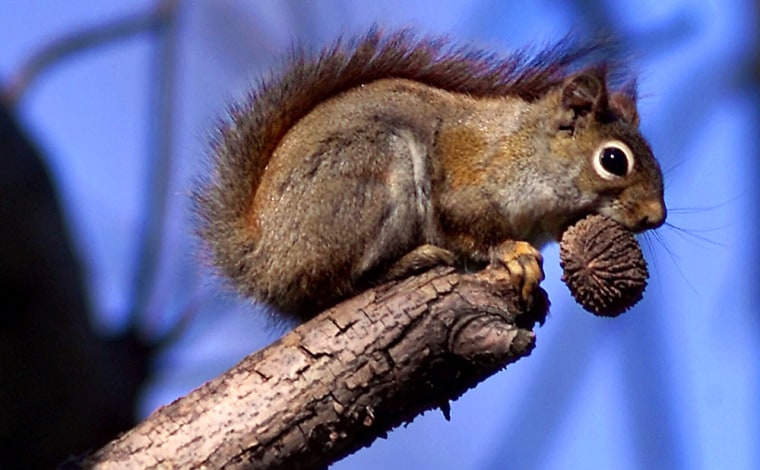The littlest potential victim of two major wildfires could be an endangered red rodent whose ancestors have lived on southeastern Arizona's Mount Graham since the Ice Age.
With flames from the Nuttall and Gibson fires lapping toward its once-prime spruce-fir habitat near the 10,700-foot summit, the Mount Graham red squirrel's future has been in even greater jeopardy than normal in recent days.
State and federal biologists have been huddling to map out contingency plans for trapping squirrels, particularly juveniles, for future breeding in the event of a complete burnout of the forest canopy that the squirrel favors.
"They are one of the most endangered mammals in the world," said University of Arizona biologist John Koprowski. "These guys have weathered fires in the past, have dealt with small habitat, and have survived. But the big concern here is that with past forest management strategies of fire suppression, these fires burn a lot hotter than they did traditionally."
Koprowski said this has been a great year for squirrel reproduction. Almost 90 percent of all adult females had litters of three to four offspring, he said.
Unfortunately, most of the young are still nursing, just out of the nest and not independent yet.
"So it (the fire) came at a horrible time," Koprowski said.
Officials estimated that as of Tuesday, the fire had impacted only 5 percent of red squirrel habitat, said Jeff Humphrey, a U.S. Fish and Wildlife Service spokesman.
The red squirrel, which weights 8 ounces and is 13 inches long, is a genetically distinct subspecies that is found nowhere else.
It has been tied in controversy for more than 20 years with development of the University of Arizona's Mount Graham International Observatory, which has also been threatened by the fires. Observatory opponents have contended the facility would result in the animal's demise.
Other threatened species
Mount Graham includes a relatively small island of only 8,000 to 10,000 acres of red squirrel habitat among spruce and fir trees above 8,000 feet elevation. It's the type of forest that can be found in the Yukon or Alaska, Koprowski said.
Other threatened species on the mountain range include the Mexican spotted owl, the Wet Canyon talussnail and the northern goshawk -- the squirrel's principal predator.
There are also small shrews, white-tailed deer, gray foxes, black bears, bobcats and mountain lions.
The red squirrel population has fluctuated markedly from year to year in recent decades, affected by weather and the availability of pine cone crops, its staple diet, and large winter dieoffs.
The latest survey, released this week, showed a population of 284 squirrels, plus or minus 13, up 10 from a fall survey.
The lowest total since annual counts began was 146, plus or minus 29, in the spring of 1989; the high came 10 years later, at 562, plus or minus 12, said Koprowski, the scientist in charge of the red squirrel monitoring project.
Koprowski said the current blaze was unlikely to wipe out every remaining squirrels.
The fire is burning in a mosaic pattern and likely would leave squirrels, he said, "but the problems are going to be left there -- forest conditions, fire suppression, lots of fuel, and deadwood." And a smaller population will heighten the prospect of genetic problems from inbreeding, he added.
'A scrappy, battling species'
During the past 2 1/2 years, biologists have trapped and placed radio collars on the squirrels to track their movement.
Before insects infested the drought-weakened spruce-fir forest, the highest squirrel populations were found in two high-elevation plots used in the census work, Koprowski said. Afterward, the numbers dropped from 50 to one or two animals per plot.
The animals were leaving their favored habitat for living trees.
But he said some smaller trees had survived the infestation, and the squirrels were just starting to recolonize them before the fires started.
"We were very optimistic about the coming year, and that optimism has pretty quickly faded," Koprowski said.
Still, the squirrels "are kind of characterized as a scrappy, battling species," he said. "I'm hopeful."
Tree ring samplings show that with the exception of the Clark Peak fire in 1996, which resulted in the loss of more than 20 red squirrels, the last major fire atop Mount Graham occurred in 1685, said Thomas Swetnam, director of the University of Arizona's Tree Ring Laboratory. He said there were frequent fires lower on the mountain from 1685 to about 1900.
The fire likely will generate new growth that attracts wildlife species back eventually, said Bill van Pelt, a spokesman for the Arizona Game and Fish Department.
